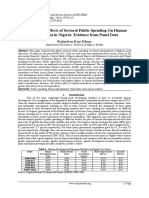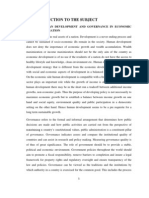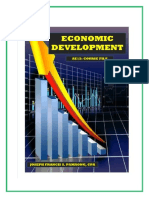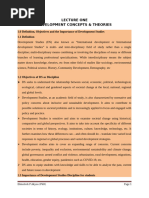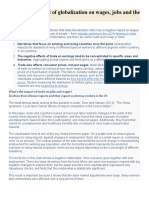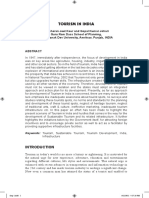Gurinder Jit Singh Bhullar
Gurinder Jit Singh Bhullar
Uploaded by
gurinderbhullarCopyright:
Available Formats
Gurinder Jit Singh Bhullar
Gurinder Jit Singh Bhullar
Uploaded by
gurinderbhullarOriginal Description:
Copyright
Available Formats
Share this document
Did you find this document useful?
Is this content inappropriate?
Copyright:
Available Formats
Gurinder Jit Singh Bhullar
Gurinder Jit Singh Bhullar
Uploaded by
gurinderbhullarCopyright:
Available Formats
REVIEW ARTICLE
Study of Political Representations:
Diplomatic Missions of Early Indian to
Britain
Journal of
Advances and
Scholarly
Researches in
Allied
Education
Vol. 3, Issue 6,
April-2012,
ISSN 2230-
7540
J ournal of Advances and
Scholarly Researches in
Allied Education
Vol. VII, Issue No. XIII,
J anuary-2014, ISSN 2230-
7540
AN
INTERNATIONALLY
INDEXED PEER
REVIEWED &
REFEREED JOURNAL
HUMAN CAPITAL STATUS IN DEVELOPING
ECONOMIES
www.ignited.in
Dr. Gurinder Jit Singh Bhullar
w
w
w
.
i
g
n
i
t
e
d
.
i
n
1
J ournal of Advances and Scholarly Researches in Allied Education
Vol. VII, Issue No. XIII, J anuary-2014, ISSN 2230-7540
Human Capital Status in Developing Economies
Dr. Gurinder Jit Singh Bhullar
Head P.G. Department of Economics, Guru Nanak College Moga
Abstract In this paper analysis has been done to study the human capital status of developing
economies. The multiple regression analysis technique was applied to see whether the effect of different
factors differs significantly between the countries. The human development index has been used as a
proxy for judging the human capital level. Attempt has been made to find the relationship of human
development index with per capita income (PPP), gross domestic saving, health expenditure as a percent
of GDP, education expenditure as a percent of GDP, labour force as a percent of total population, share of
non-agriculture sector as a percent of GDP, percentage of labour force in non-agriculture sector.
- - - - - - - - - - - - - - - - - - - - - - - - - - - - - - - - - - - X - - - - - - - - - - - - - - - - - - - - - - - - - - - - - - - - - -
INTRODUCTION
Human beings are the real carriers of all activities and
development must be centered on enhancing their
achievements, freedoms and capabilities. It is the
lives they lead that are of intrinsic importance, not the
commodities or income that they happen to possess.
Living standard cannot be measured solely by the
amount of income, commodities or the wealth though
they constitute important parameters for the same. A
person's income level, for example, does not reveal
what expectation of life the person has, whether he or
she is presently healthy (or suffering from a disease),
is disabled and is capable of moving about freely etc.
Even for those features of the living standard where
the instrumental significance of private income is likely
to be greater, such as adequate nutrition, there is
enormous variation in converting income into achieved
well-being. Sen (1988)
An initial heavy investment in human resource
development is necessary to get a country started on a
road to self-sustaining growth. The magnitude of
required investment in human resource development
for continued growth is itself a function of the level of a
country's economic development. There is a high
correlation and presumably some causal relation
between enrollments in education and a country's level
of economic development as expressed by GNP per
capita. The balance in any programme of human
resource development is as important as the amount
of investment in education. The social and political
pressures for education are powered by economic
motivations and due to this an educational system
which fails to prepare persons for available jobs is
clearly out of balance and is by any definition
inefficient. The proportion of national income devoted
to human resource development is likely to rise in all
countries that are growing with the increase in quantity
of education and thus the need for improvement in the
quality becomes imperative. Harbison (1962) the
human resources are the ultimate basis of the wealth
of nations. The developing countries come across
with two major problems: firstly underutilization of the
capacities of human beings as indicated by rising
unemployment and underemployment in both rural
and urban areas, due to high rates of population
growth; and secondly the under development of the
capacities of human agents for productive use of their
energies. Further, study found that there is no
serious conflict between maximizing employment
opportunities and maximizing national income. The
standard of living of a society should not be judged by
GNP per capita and the supply of particular goods but
by people capabilities in what a person can or cannot
do. It is entitlements - the set of alternative
commodity bundles that a person can command in
society. The relevant capabilities are being free from
starvation, hunger, under-nourishment. The
expansions of these capabilities implies freedom of
choice.
Due to globalization lakhs of people have been facing
new situation of trade and work. Technical changes
taking place all over the world and the investment
done by the foreigner in a particular country has
made human developments possible in the best
possible ways. The expenses of the media and
internet have revolutionized the communication
system which is helping human advancement. Global
markets are expanding in a fast way in this time. New
challenges are being thrown upon by globalization.
But these challenges do not put impediments in the
expansion of global market. Such challenges make
way for better and strong governance so that
advantages of global market are not only sustained
rather they provide much scope for competition very
much required for optimum use of resources and
ultimately for the betterment of the people.
Dr. Gurinder Jit Singh Bhullar
w
w
w
.
i
g
n
i
t
e
d
.
i
n
2
Human Capital Status in Developing Economies
In this knowledge era the value of human capital has
taken the prime slot. The education system as a
whole has been a subject of continuous evaluation and
reinforcement. The role of education and training in
enhancing the chances of better quality of life,
prosperity and peace is being appreciated worldwide.
(Ghailani & Khan, 2004).
Development planning is necessary for economic
growth that leads to better human lives. Better human
lives only can further lead to increased development
choices for the people. Again development planning
must form the basis for undertaking development
programmes and projects and the exercise must be
carried out before the start of the programmes. Due
weightage should be given to skills over and above the
technical and financial viability. The most important
aspect of development programmes and projects is
not the completion of such activities but the persons
who would be actually benefited from such
programmes. As such the direction of the
programmes should intend to and actually reduce the
imbalances in socio-economic sphere. The aim of
developmental activities should be targeted to the
betterment of people's life and their living standard
rather than the production and the cost of production.
That is to say that how better can the lives of the
people be shaped. To illustrate it further we can take
the example of health facilities where the aim should
not only be improving health but it should be health for
all. Again the other case of housing can be taken
where aim should not be improved housing but it
should be housing for the needy and the poor (HDR,
1991).
In this paper analysis has been done to study the
human capital status of developing countries. The
multiple regression analysis technique was applied to
see whether the effect of different factors differs
significantly between the countries. The human
development index has been used as a proxy for
judging the human capital level. Attempt has been
made to find the relationship of human development
index with per capita income (PPP), gross domestic
saving, health expenditure as a percent of GDP,
education expenditure as a percent of GDP, labour
force as a percent of total population, share of non-
agriculture sector as a percent of GDP, percentage of
labour force in non-agriculture sector.
REVIEW OF LITERATURE
Dhesi (1979) found that there is a definite relationship
between technologies used by a society and the
pattern of human development. A technically
changing society creates new products, new centers of
economic activity, requires new skills replacing the old
ones. This demands a certain degree of mobility of
human resources between regions, sectors as well as
skills Shariff and Unni (1999) studied the human
development and growth scenario of the South Asian
economies to examine the rationale for mass
education among the young. Study concluded that to
ensure participation and involvement in the education
sector, a direct financing and local fiscal contribution of
the community at large and of parents in particular was
essential. Cervellati and Sunde (2002) provided a
unified theory of the transition in income, life
expectancy, education and population experienced by
the Western world when passing from an environment
of economic stagnation to sustained growth. Wages
which are determined by productivity and life
expectancy are the crucial variables in the individual
education decision. The advances in the technological
progress, human capital formation and longevity
potential reinforce each other. Datt (2002) aimed the
improvement in human development index in India vis-
a-vis other countries of the world. The study found
that the population growth rate has begun to decline
and it is estimated that it would be 1.3 percent per
annum during 1999-2015. This will release quite a
significant proportion of the resources being currently
used to support a higher growth rate of population for
other areas of development. Ranis (2001)gives the two
way relationship between economic growth and
human development which suggests that nations may
enter either into a virtuous cycle of high growth and
large gains in human development or a vicious cycle of
low growth and low rates of HD improvement. Ignacio
(2003) studied the dynamic relationship between
consumptions and human capital investments. The
study found that the risk is not the only parameter with
respect to investment of human capital for seeking
premium on these human capital investments that are
risk free under reasonable preference parameters.
Chadha (2004) opined that human capital most
ostensibly in the form of education would be an
inescapable input for ensuring competitive levels of
productivity in various sectors and for accelerating the
overall face of economic growth of Indian economy.
The study underscores that a poor human capital base
is the "Achilles' heel" of Indian economyStewart (2010)
studied the trends in human development in Europe in
the last two decades. The study found that levels of
both relative poverty and overall income inequality
were on the rise across most of the region.
DATA SOURCES AND METHODOLOGY
The data used in the study were collected from various
publications of World Bank, United Nations and World
Health Organization that are available in India.
Publications like World Development Reports, Human
Development reports, World Statistics, UNESCO
statistical year books, U.N. Demography Year Books
The analysis has been carried out at three points of
time viz for the years 1985, 1995 and 2005. The
purpose behind this was to study the changes over a
long period of time. In order to find the human
development level of developing countries
econometric approach based on regression is used in
the form of following equation.
HDI
it
1it
+
11
lnPCI
it
+
12
lnGDS
it
+
13
ln HE
it
+
14
lnEE
it
+
Dr. Gurinder Jit Singh Bhullar
w
w
w
.
i
g
n
i
t
e
d
.
i
n
3
J ournal of Advances and Scholarly Researches in Allied Education
Vol. VII, Issue No. XIII, J anuary-2014, ISSN 2230-7540
15
ln LFP
it
+
16
ln UP
it
+
17
ln SNA
it
+
18
ln LFNA
it
+
U
it
RESULTS AND DISCUSSION
Analysis for the year 1985
The cross country regression result for all the
developing countries for the year 1985 are presented
in the table 1 The results of the regression analysis as
given by equation I shows that 75.3 percent variation
in the dependent variable are explained by the set of
explanatory variable under study. The coefficient of
per capita income (PPP) is positive and significant at
one percent level. This means that as the per capita
income increases the human capital level increased
significantly in the year 1985. The coefficient of
percentage of labour force in non-agriculture sector is
positive and significant at one percent level of
significance. This is due to the fact that as the labour
force in non-agriculture sector increases their income
increases. The increase in income lead to better
standard of living of people and hence increase in
human development index which signifies the increase
of human capital level. The coefficient of urban
population as a percent of total population is negative
and significant at five percent level of significance.
The coefficient of gross domestic saving, health
expenditure as a percent of GDP, labour force as a
percent of total population and share of non-agriculture
sector as a percent of GDP are positive but non-
significant. The coefficient of health expenditure as a
percent of GDP is .016. This indicates that if there is 1
percent increase in the health expenditure the human
development index will increase by .016 percent.
The analysis has also been done to find the
relationship by excluding the variable per capita
income. The equation II of the table shows that 68.3
percent variations in the dependent variable are
explained by the explanatory variables under
consideration. The coefficient of health expenditure as
a percent of GDP and share of non-agriculture sector
as a percent of GDP are positive and significant at five
percent level of significance. The coefficient of
percentage of labour force as a percent of total
population remained positive and significant at one
percent level and that of urban population as a percent
of total population is negative and significant at five
percent level of significance.
Table 1
Regression Results for the year 1985
ANALYSIS FOR THE YEAR 1995
The cross country regression results for human
capital status for the year 1995 are presented in the
table-2. The equation I of the table show that 79.7
percent variations in the dependent variable are given
by the set of explanatory variables under study. The
coefficient of per capita income (PPP) is found to be
positive and significant at one percent level of
significance. The coefficient of share of non-
agriculture sector as a percent of GDP is positive and
significant at five percent level and the coefficient of
percentage of labour force in non- agriculture sector
is positive and significant at one percent level of
significance.
Table 2
Regression Results for the year 1995:
The coefficient of gross domestic saving, health
expenditure, education expenditure as a percent of
GDP, labour force as a percent of total population are
positive but non-significant. The coefficient of labour
force as a percent of total population is .021
indicating that if there is one percent increase in the
Dr. Gurinder Jit Singh Bhullar
w
w
w
.
i
g
n
i
t
e
d
.
i
n
4
Human Capital Status in Developing Economies
labour force as a percent of total population the human
development index will increase by .021 percent.
The analysis has also been made to find the
relationship by excluding the variable per capita
income (PPP). The equation II of the table shows that
75 percent variations in the dependent variable are
explained by the explanatory variables under study.
The coefficient of gross domestic saving and health
expenditure as a percent of GDP are positive and
significant at five percent level of significance. The
coefficients of share of non-agriculture sector as a
percent of GDP become positive and significant at one
percent level of significance. The coefficient of urban
population as a percent of total population remained
negative and significant at 10 percent and that of
percentage of labour force in non- agriculture sector
positively significant at one percent level of
significance.
ANALYSIS FOR THE YEAR 2005
The cross country regression results for human capital
status for developing countries for the year 2005 are
presented in the table 3. The equation I of the table
shows that 88.6 percent variations in the dependent
variable are explained by the explanatory variables
under study. The coefficients of per capita income
(PPP) and percentage of labour force as a percent of
total population are positive and significant at one
percent level of significance. The coefficient of labour
force as a percent of total population and coefficient of
share of non-agriculture sector as a percent of GDP
are positive and significant at five percent level of
significance. The coefficient of urban population as a
percent of total population is negative and significant
at five percent level of significance. The coefficient of
gross domestic saving, health expenditure and
education expenditure are positive but non-significant.
Analysis has also been made to find the relationship
by excluding the variable per capita income. The
equation II of the table shows that 83.4 percent
variations in the dependent variable are explained by
the explanatory variables. The coefficient of health
expenditure as a percent of GDP is positive and
significant at five percent level of significance. The
coefficient of labour force as a percent of total
population and share of non-agriculture sector became
significant at one percent level of significance.
Table 3
Regression Results for the year 2005
The study found that over a period from 1985 to 2005
the value of
2
R
increased to 88.6 percent in 2005
from 75.3 in 1985. The increase in
2
R
indicates that
the effects of explanatory variable on the dependent
variable have increased. The coefficient of per capita
income and coefficient of percentage of labour force in
non-agriculture sector and coefficient share of non-
agriculture sector as a percent of GDP remained
positively significant throughout the study period. The
coefficient of urban population as a percent of total
population remained negatively significant throughout
the study period. The coefficient of gross domestic
saving was positive but non-significant in 1985. It
became significant in 1995 when the variable per
capita income was excluded from the list.
The coefficient of health expenditure was positively
significant throughout the period of study when the
variable per capita was excluded. The coefficient of
education expenditure as a percent of GDP remained
positive but non-significant during the period of study.
The coefficient of labour force as a percent of total
population was positive but non-significant in 1985 and
1995 but became significant in the year 2005.
REFERENCES
Cervellati Matteo and Uwe Sunde (2002),
Human Capital Formation, Life Expectancy
and The Process of Economic Development,
IZA Discussion Paper No. 585
Chadha G.K. (2004), "Human Capital Base of
the Indian Labour Market: Identifying Worry
Spots". The Indian Journal of Labour
Economics, 47(1), 3-38.
Datt Ruddar (2002), "Human Development;
India and World Context", The Indian Journal
of Labour Economics, 45(2).
Dr. Gurinder Jit Singh Bhullar
w
w
w
.
i
g
n
i
t
e
d
.
i
n
5
J ournal of Advances and Scholarly Researches in Allied Education
Vol. VII, Issue No. XIII, J anuary-2014, ISSN 2230-7540
Dhesi Autar S. (1979), Human Capital
Formation and its Utilization, Sterling
Publishes Pvt. Ltd., New Delhi.
Ghailani Juma and Sami A. Khan (2004),
"Quality of Secondary Education and Labour
Market Requirement", Journal of Services
Research, 4(1), 127-138.
Harbison, F.H. (1962), Human Resources in
Development Planning in Modernizing
Economics, International Labour Review,
85(5), 2-23.
Ignacio Palacios-Huerta (2003), "Risk and
Market Frictions as Determinants of the
Human Capital Premium", Department of
Economics; Brown University
http://works.bepress.com
ILO, Year Book of Labour Statistics, Geneva:
Various Issues.
Ranis Gustav, Frances Stewart (2001), Gross
and Human Development: Comparative Latin
American Experience, The Developing
Economies, 39(4), 333-365.
Sen, A. (1988), "The Concept of
Development", in Hollis Chenery and T.N.
Srinivasan (eds.), Handbook of Development
Economics, Amsterdaim: North Holland.
Shariff, A. and J. Unni (1999), "Enabling
Development through Education Implications
of South Asia", Labour and Development, 5(1)
(Dec.), 31-53.
Stewart, Kitty (2010), Human Development in
Europe,
http//d.repec.org/n?u=RePEc:hdr:papers:hdrp-
2010-07 & r=hrm.
United Nations Development Programme
(UNDP), Human Development Reports, New
York, Oxford University Press: Various Issues.
United Nations Educational Scientific and
Cultural Organization (UNESCO), Statistical
Year Book, Paris: Various Issues.
You might also like
- Thesis Report - Housing With Sustainable TechnologiesDocument102 pagesThesis Report - Housing With Sustainable Technologiesshravanigupta91% (11)
- Human Development and HDIDocument8 pagesHuman Development and HDITushar PanchalNo ratings yet
- HDI of Jammu & Kashmir by Adnan NisarDocument11 pagesHDI of Jammu & Kashmir by Adnan NisarvoiddterminalNo ratings yet
- Expenditure On Human Capital and Economic Growth Evidences Form NepalDocument11 pagesExpenditure On Human Capital and Economic Growth Evidences Form NepalHADDOU OUATTARNo ratings yet
- Syed Ammad Ali Hasan Raza and Muhammad Umair YousufDocument15 pagesSyed Ammad Ali Hasan Raza and Muhammad Umair YousufsangnahkodaNo ratings yet
- The Impact of Human Capital Development On The Economic Growth of NigeriaDocument10 pagesThe Impact of Human Capital Development On The Economic Growth of NigeriaUmar FarouqNo ratings yet
- Human Development in IndiaDocument13 pagesHuman Development in IndiaMohit PaswanNo ratings yet
- (Goswami Dan Bezbaruah, 2011) Social Sector Expenditures and Their Impact On Human Development - The Indian ExperienceDocument21 pages(Goswami Dan Bezbaruah, 2011) Social Sector Expenditures and Their Impact On Human Development - The Indian Experiencepablo telussaNo ratings yet
- Dev PAPER 1Document6 pagesDev PAPER 1Paul AriolaNo ratings yet
- Human Capital Development As Sources of Economic Growth in Nigeria: An Empirical ReviewDocument9 pagesHuman Capital Development As Sources of Economic Growth in Nigeria: An Empirical ReviewUmar FarouqNo ratings yet
- Impact of Human Capital Development in Economic - Nigeria 2020Document13 pagesImpact of Human Capital Development in Economic - Nigeria 2020Toavina RASAMIHARILALANo ratings yet
- Analyzing The Effects of Sectoral Public Spending On Human Development in Nigeria: Evidence From Panel DataDocument13 pagesAnalyzing The Effects of Sectoral Public Spending On Human Development in Nigeria: Evidence From Panel Dataakita_1610No ratings yet
- The Impacts of Health and Education Components of Human Resources Development On Poverty Level in Nigeria, 1980-2013.Document6 pagesThe Impacts of Health and Education Components of Human Resources Development On Poverty Level in Nigeria, 1980-2013.IOSRjournalNo ratings yet
- B. Human Capital Can Only Be Implemented Successfully in A Developed Country (America, Britain, Japan, EtcDocument2 pagesB. Human Capital Can Only Be Implemented Successfully in A Developed Country (America, Britain, Japan, EtcMhmmd RiyandiNo ratings yet
- Critical Review of Past Literature On Human Resource Development in The WorldDocument5 pagesCritical Review of Past Literature On Human Resource Development in The WorldIJARP PublicationsNo ratings yet
- Main Sandra's Impact of Human Capital Development On Economic Growth in NigeriaDocument36 pagesMain Sandra's Impact of Human Capital Development On Economic Growth in NigeriaHaidee BellaNo ratings yet
- Growth: Liberalisation. It Is Now Widely Acknowledged That The Resulting Structural Reforms Led ToDocument4 pagesGrowth: Liberalisation. It Is Now Widely Acknowledged That The Resulting Structural Reforms Led Tojishnujraju123No ratings yet
- Human Development - Meaning, Objectives and ComponentsDocument7 pagesHuman Development - Meaning, Objectives and ComponentsVijay Kulkarni50% (2)
- TOPIC7 Human Development Concept Components and MeasurementsDocument11 pagesTOPIC7 Human Development Concept Components and Measurementsinkbeats96No ratings yet
- Human Capital Investment and Development in NigeriaDocument9 pagesHuman Capital Investment and Development in NigeriaVincent Owede MosesNo ratings yet
- Economics Online Class #2Document6 pagesEconomics Online Class #2RoseNo ratings yet
- Final WorkDocument20 pagesFinal WorkSSENYANGENo ratings yet
- Government Expenditure and Human Capital Development in Nigeria: An Auto-Regressive Distributed Lagged Model Approach (ARDL)Document16 pagesGovernment Expenditure and Human Capital Development in Nigeria: An Auto-Regressive Distributed Lagged Model Approach (ARDL)Olayinka DamilolaNo ratings yet
- Development ParadigmsDocument11 pagesDevelopment ParadigmsAswin Sreenivasan100% (1)
- Development Economics Module Prepared by FikaduDocument85 pagesDevelopment Economics Module Prepared by Fikadub65119055No ratings yet
- 1 PB PDFDocument9 pages1 PB PDFhinirobNo ratings yet
- Inter StateDocument12 pagesInter StateItz GurpreetNo ratings yet
- JPSP 2022 065Document12 pagesJPSP 2022 065Nawang W. L.No ratings yet
- Development ExamDocument15 pagesDevelopment Examibrahim b s kamaraNo ratings yet
- Development Studies FullDocument69 pagesDevelopment Studies Fullfadhilimathias6823No ratings yet
- Final Work TodayDocument18 pagesFinal Work TodaySSENYANGENo ratings yet
- Asian Economic and Financial Review 2 (7) :813-827Document15 pagesAsian Economic and Financial Review 2 (7) :813-827rudyNo ratings yet
- Economic Growth and Economic DevelopmentDocument2 pagesEconomic Growth and Economic DevelopmentmananmuhammadNo ratings yet
- A Comparative Analysis of Human Development Index in Four States of IndiaDocument14 pagesA Comparative Analysis of Human Development Index in Four States of IndiamohsinaNo ratings yet
- SOCIAL Sector SpendingDocument20 pagesSOCIAL Sector Spendingvikrant vardhanNo ratings yet
- Carribean EssayDocument2 pagesCarribean Essayyacegeh627No ratings yet
- Growth and DevelopmentDocument20 pagesGrowth and Developmentgeetupatel9852No ratings yet
- What Development Promises: Different People, Different GoalsDocument4 pagesWhat Development Promises: Different People, Different GoalsUma MishraNo ratings yet
- Module 4-Economic DevelopmentDocument3 pagesModule 4-Economic Developmentjessafesalazar100% (1)
- Fifty Years of Bangladesh: Achievement in Population SectorDocument6 pagesFifty Years of Bangladesh: Achievement in Population SectorInternational Journal of Business Marketing and ManagementNo ratings yet
- Role of Teachers and Teachers Association in Attaining Sustainable Development Goal of United NationsDocument7 pagesRole of Teachers and Teachers Association in Attaining Sustainable Development Goal of United Nationsarif asgarNo ratings yet
- BABACCA EditedDocument21 pagesBABACCA EditedOlansaNo ratings yet
- Soc - Audit Manual RRP - Doc 6.9.07 LandscapeDocument653 pagesSoc - Audit Manual RRP - Doc 6.9.07 LandscapeSamgar SangmaNo ratings yet
- 1.1 Introduction To The Subject: Role of Human Development and Governance in Economic Growth of A NationDocument47 pages1.1 Introduction To The Subject: Role of Human Development and Governance in Economic Growth of A NationsiddharthramanNo ratings yet
- Economic Growth and Poverty Reduction in Nigeria An Empirical InvestigationDocument14 pagesEconomic Growth and Poverty Reduction in Nigeria An Empirical InvestigationAlexander DeckerNo ratings yet
- Economics - CH 1Document4 pagesEconomics - CH 1nidhiNo ratings yet
- Chapter 10: Economic Growth and Technical Progress: ObjectivesDocument12 pagesChapter 10: Economic Growth and Technical Progress: ObjectivesCristi YssayNo ratings yet
- Princewill ProjectDocument55 pagesPrincewill Projectgodwinelishafrnklin1No ratings yet
- Ge So 42Document396 pagesGe So 42avsaam56No ratings yet
- Economic Policies of IndiaDocument35 pagesEconomic Policies of IndiaVishant BothraNo ratings yet
- Module 1 - Economic DevelopmentDocument3 pagesModule 1 - Economic DevelopmentjessafesalazarNo ratings yet
- Scope of Human DevelopmentDocument10 pagesScope of Human DevelopmentBernadetteBalaguer75% (4)
- Ae12 Course File Econ DevDocument49 pagesAe12 Course File Econ DevEki OmallaoNo ratings yet
- Human Resource Development: "Not Everything That Can Be Counted Counts and Not Everything That Counts Can Be Counted."Document29 pagesHuman Resource Development: "Not Everything That Can Be Counted Counts and Not Everything That Counts Can Be Counted."Malik Hassan GulNo ratings yet
- Book 5 Development EconomicsDocument83 pagesBook 5 Development EconomicsTaufeek IrawanNo ratings yet
- Dynamics of Human Development: Chapter:TwelveDocument6 pagesDynamics of Human Development: Chapter:TwelveSumit SharmaNo ratings yet
- Indicators of DevelopmentDocument2 pagesIndicators of DevelopmentSarah Dane LisingNo ratings yet
- RPD - AssignmentDocument17 pagesRPD - AssignmentYusuf MunshiNo ratings yet
- Select Dimensions of Measuring Human DevelopmentDocument47 pagesSelect Dimensions of Measuring Human Developmentarnab1988ghoshNo ratings yet
- DS 2020-1 2Document105 pagesDS 2020-1 2georgepaschal21No ratings yet
- Hunar Se Rozgar TakDocument70 pagesHunar Se Rozgar TakSunil KumarNo ratings yet
- Morris JGHdefDocument7 pagesMorris JGHdefmuhammad aliNo ratings yet
- Review and Appraisal of Research Evidences Generated To Harness The Demographic Dividend in EthiopiaDocument16 pagesReview and Appraisal of Research Evidences Generated To Harness The Demographic Dividend in EthiopiaCentral Asian StudiesNo ratings yet
- Agricultural Credit and Its Impact On Farm Productivity: A Case Study of Kailali DistrictDocument43 pagesAgricultural Credit and Its Impact On Farm Productivity: A Case Study of Kailali Districtajay adhikariNo ratings yet
- Chapter Two: Economics of Agricultural DevelopmentDocument40 pagesChapter Two: Economics of Agricultural DevelopmentHaile Girma100% (1)
- Mapping of Economics ModulesDocument5 pagesMapping of Economics ModulesHanh An Nguyen HoangNo ratings yet
- Mark Setterfield - The Economics of Demand-Led Growth - Challenging The Supply-Side Vision of The Long Run PDFDocument306 pagesMark Setterfield - The Economics of Demand-Led Growth - Challenging The Supply-Side Vision of The Long Run PDFAlex Rilie100% (2)
- Wallerstein - La Imagen Global y Las Posibilidades Alternativas de La Evolución Del Sistema MundoDocument33 pagesWallerstein - La Imagen Global y Las Posibilidades Alternativas de La Evolución Del Sistema MundoSean Rimada GoldsmithNo ratings yet
- A Recession Is When Your Neighbour Loses His Job. A Depression Is When You Lose Your JobDocument83 pagesA Recession Is When Your Neighbour Loses His Job. A Depression Is When You Lose Your JobAppurva SharmaNo ratings yet
- Maritime Logistics A Guide To Contemporary Shipping and Port Management (051-100)Document50 pagesMaritime Logistics A Guide To Contemporary Shipping and Port Management (051-100)ZaNo ratings yet
- Real Estate and Construction Sector in The UAEDocument20 pagesReal Estate and Construction Sector in The UAERoshan de SilvaNo ratings yet
- Unido Publication 2019 14100685Document184 pagesUnido Publication 2019 14100685abdulber kedirNo ratings yet
- What's The Impact of Globalization On Wages, Jobs and The Cost of Living?Document17 pagesWhat's The Impact of Globalization On Wages, Jobs and The Cost of Living?RIZLE SOGRADIELNo ratings yet
- Energy ScenarioDocument152 pagesEnergy ScenariogowrishankarplNo ratings yet
- PPTDocument137 pagesPPTSwati GautamNo ratings yet
- The Environmental Kuznet Curve (EKC)Document3 pagesThe Environmental Kuznet Curve (EKC)Tamash MajumdarNo ratings yet
- NothingbutNet 2008InternetInvestmentGuideDocument312 pagesNothingbutNet 2008InternetInvestmentGuideUbaid DhiyanNo ratings yet
- The Third Round in Poland - Peter GowanDocument40 pagesThe Third Round in Poland - Peter GowanpeterVoterNo ratings yet
- Analysis of The Economic Survey 2022-23Document39 pagesAnalysis of The Economic Survey 2022-23Umair NeoronNo ratings yet
- Paper 4 PYQDocument16 pagesPaper 4 PYQSaurabh PatelNo ratings yet
- Comparative Analysis of Advantages and Disadvantages of The Modes of Entrying The International MarketDocument9 pagesComparative Analysis of Advantages and Disadvantages of The Modes of Entrying The International MarketTròn QuayyNo ratings yet
- Hunger and MalnutritionDocument60 pagesHunger and Malnutritionerlina_rachmawatiNo ratings yet
- Compensation Management: Realigning Fixed and Variable PayDocument13 pagesCompensation Management: Realigning Fixed and Variable PaymadhpanNo ratings yet
- EconDevt 8-9Document14 pagesEconDevt 8-9Mark AlcazarNo ratings yet
- Unit V Trends in Software Economics Case Study 1-Impact of Properly Licensed SoftwareDocument12 pagesUnit V Trends in Software Economics Case Study 1-Impact of Properly Licensed SoftwareTarun MittalNo ratings yet
- ConsumarismDocument14 pagesConsumarismAmritendu BagNo ratings yet
- Tourism in IndiaDocument10 pagesTourism in IndiaIop UioNo ratings yet
- Paul BaranDocument4 pagesPaul Barannischal1077No ratings yet
- Dealer Perception About Kansai Nerolac Paints Ltd.Document113 pagesDealer Perception About Kansai Nerolac Paints Ltd.sankritrai100% (12)











